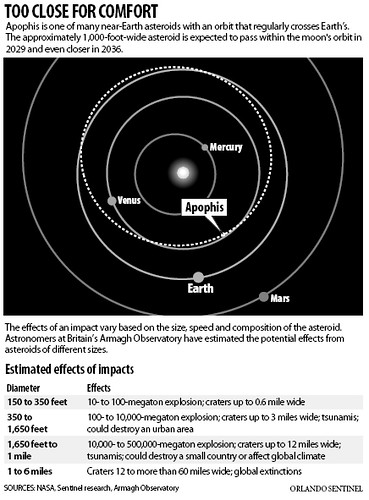A Date with Apophis; or, Killer Asteroids
I wouldn’t change your plans yet (though you might want to get busy practicing the Ameriroids game), but Michael Cabbage at the Orlando Sentinel reports on the progress of NASA’s program to identify asteroids that cross the earth’s orbit — and takes a look at the odds of a an asteroid striking the earth in the coming decades:

Mark your calendar for Sunday, April 13, 2036. That’s when a 1,000-foot-wide asteroid named Apophis could hit the Earth with enough force to obliterate a small state.
The odds of a collision are 1-in-6,250. But while that’s a long shot at the racetrack, the stakes are too high for astronomers to ignore.
For now, Apophis represents the most imminent threat from the worst type of natural disaster known, one reason NASA is spending millions to detect the threat from this and other asteroids….
Objects this size are thought to hit Earth about once every 1,000 years, and, according to recent estimates, the risk of dying from a renegade space rock is comparable to the hazards posed by tornadoes and snakebites. Those kind of statistics have moved the once-far-fetched topic of killer asteroids from Hollywood movie sets to the halls of Congress.
"Certainly we had a major credibility problem at the beginning — a giggle factor," said David Morrison, an astrobiologist at NASA’s Ames Research Center in Mountain View, Calif. "Now, many people are aware this is something we can actually deal with, mitigate and defend against."
In 1998, lawmakers formally directed NASA to identify by 2008 at least 90 percent of the asteroids more than a kilometer (0.6 mile) wide that orbit the sun and periodically cross Earth’s path. That search is now more than three-quarters complete.
Last year, Congress directed the space agency to come up with options for deflecting potential threats. Ideas seriously discussed include lasers on the moon, futuristic "gravity tractors," spacecraft that ram incoming objects and Hollywood’s old standby, nuclear weapons.
To help explore possible alternatives, former Apollo astronaut Rusty Schweickart has formed the B612 Foundation. The organization’s goal is to be able to significantly alter the orbit of an asteroid in a controlled manner by 2015.
For those so inclined, more things to worry about can be found on the NASA Near Earth Object Program website.
Bloggers Blog also has a roundup of other posts on Apophis fron around the blogosphere.
